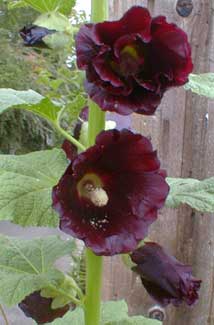
Black Hollyhock
"Here beside the modest stock
Flaunts the flaring hollyhock."
-Henry Austin Dobson
(1840-1921)
(1840-1921)
The "Nigra" variant of Alcea rosea is as nearly black as any flower gets. It is an heirloom variety which Thomnas Jefferson grew. The species is native to the Mediterranean region, & has been gardened throughout Europe since at least 1500. The black form was described in 1629 by John Parkinson as, "Of darke red like black blood."
It is an easily self-seeding biennial or shortlived perennial which will live two to five years. It grows swiftly to an enormous height. The main plant is only a foot & a half, but the gigantic flower spikes are "small" at five feet, & frequently eight or ten feet tall!
The individual maroon-black flowers all over these spikes are two or three inches across. It blooms from May or June; deadheading extends bloom to summer's end.The flowers make excellent bouquets & are liked by butterflies, bees, & hummingbirds.
Toward autumn the basal foliage begins to look spotted & poor, hence is usually regarded as a back-border plant not only because of its extreme height, but because it is not "specimen worthy" as a center of attention, though splendid for ongoing bloom in the background.
It's other fault is the flower-weighted spikes are apt to fall over in hard weather so will either need staking or preferrably to grow against a fence or barn wall. It should be cut to the ground early autumn when the final blooms go to seed.
Black Hollyhock requires a dryish light or poor soil in full sun area to do well, & where it will be low-maintenance. To get them started, seeds should be sewn in the summer. Rosettes of big hairy leaves will develop by autumn then die back before winter. It will bloom the following summer. And how it will bloom!